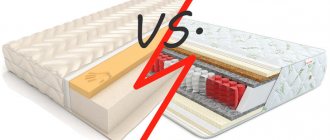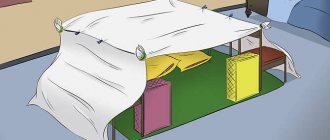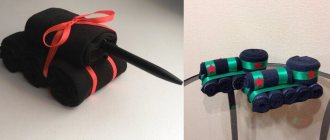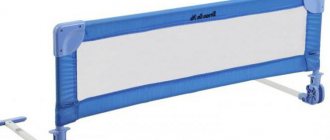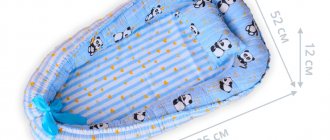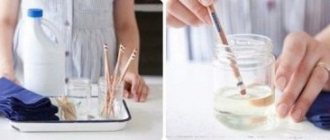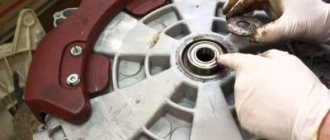To increase efficiency and overall well-being, the body needs quality rest. The most important aspect of good rest is good sleep. What will help improve your sleep quality? First of all, a comfortable sleeping place.
A comfortable mattress gives you sound sleep and good health. Therefore, you should pay special attention to your mattress.
A properly selected mattress will ensure a sound sleep. Manufacturers offer a wide selection of various materials with various fillers. Models range from budget to premium. To take into account all individual needs, you will have to shell out a large amount.
Finding a comfortable, high-quality mattress at a low price can be difficult. Sometimes it's easier to make a mattress yourself.
If the amount turns out to be too large for you, there is a way out - to make a mattress with your own hands. This solution will allow you to save money, create an ideal sleeping place for yourself, and thereby ensure healthy, sound sleep.
A mattress made by yourself can be no worse than an analogue from the manufacturer.
There are several types of mattresses that you can actually make yourself. These include:
- foam;
- orthopedic;
- from pillows.
With your own hands, you can create any mattress to your taste: either from ordinary foam rubber or from pillows.
If you have an old, worn-out mattress, just renovate it, it’s even cheaper!
An old mattress can easily be turned into a new one - you just need to properly repair it and replace the cover!
How to make a foam mattress with your own hands
Foam rubber (polyurethane foam, PPU) is perfect as a filler; it is cheap and durable. There are many types of foam rubber. They are distinguished by their quality characteristics: density, elasticity, rigidity.
The easiest way to make a mattress is from foam rubber. You can choose material of any suitable thickness.
The ideal filler is soft, elastic foam rubber, which can quickly restore its original shape after use. The quality of polyurethane foam is determined by its density. The filler must have a density in the range from 25 to 40 kg/m3. To make the frame, foam rubber with a higher density is required.
A foam mattress is the simplest and most convenient to make. In order to do it, you do not need special knowledge.
When selecting foam rubber, you must take into account the product labeling; choose a product with the designations EL (high rigidity, load up to 100 kg inclusive, low price; service life 5 years), HR or VE (have high breathability, elasticity, quite soft, service life from 10 years).
It is important to choose the right thickness and density of foam rubber for the future mattress, and also pay attention to the markings.
Before you start working, please note that for permanent mattresses you will also need spring blocks, for portable ones - only polyurethane foam.
In order to make a foam mattress with your own hands, you will need:
- glue - you will need a special one for gluing foam rubber (it is not recommended to skimp on the adhesive composition, cheap brands can be harmful to health);
- dense foam rubber is the basis of the frame, inside of which soft polyurethane foam (EL, HR or VE) is located;
- fabric for sewing a cover.
To make it, a standard set of tools is suitable: tape measure, ruler (for measurements), knife, scissors. The fastest way to make a cover is on a sewing machine, but you can get by with a thread and a needle if you don’t have one.
Prepare the necessary tools to make your own foam mattress.
To understand how to make a mattress with your own hands, use the step-by-step instructions.
- Decide on the sizes.
- Assemble the frame. Its purpose is to give the product the desired shape. Use high-density polyurethane foam (average width 7-8 cm). Cut the bars to the required size, place them on a flat surface, generously lubricate them with special glue at the joints.
- Place the filler into the finished frame (use a solid sheet of foam rubber up to 15 cm thick), after cutting out a piece of a suitable size. If you can't find thick polyurethane foam, take thin sheets (<5 cm) and glue them together.
How to make a mattress cover
To make it you will need fabric, thread and a sewing machine. You can equip the mattress cover with zippers so that it can be removed and washed.
First you need to measure the finished mattress in length, width and height. After this, make a pattern of 2 parts, top and bottom, leaving seam allowances of 3-4 cm, and a strip that will encircle the side parts. Then they are all sewn together and the finished cover is put on the mattress. It is worth considering that the cover should fit as tightly as possible, and it can be quite difficult to put on.
If desired, you can make a simplified version of the mattress cover, for example, with corner elastic bands or with elastic around the perimeter.
How to make a mattress with orthopedic properties
To maintain the tone of the musculoskeletal system, an orthopedic mattress is needed. The decision to make ordinary foam rubber orthopedic will add several steps when laying the filler.
You can also make an orthopedic mattress with your own hands. This will require different layers of filler.
In the inner part of the finished frame, layers of foam rubber and other materials are placed alternately; it is better to use struttofiber or coconut coir (control the rigidity of the product; the smaller the layer, the softer), the layers must be carefully combined using an adhesive composition, spreading it over the surface.
Another way is to use spring blocks instead of foam rubber to increase strength, but this is more labor-intensive and expensive.
A more difficult option is to make your own mattress with spring blocks. It will require more time and expense.
Which filler to choose
The filling may be different, because the child will always lie on the mattress in clothes. There are several main options:
Product thickness
- synthetic fluff;
- foam;
- batting;
- coconut bark
But in any case, you need to be attentive, since no one knows how the baby and his body will react to this or that filler. Some children cannot tolerate padding polyester and the skin immediately begins to turn red. Many seamstresses do not recommend using foam rubber as a filler. Because under the weight of the child it will quickly crumple and lose its shape. However, foam rubber will be the cheapest material and will help significantly save money.
DIY pillow mattress
The fastest, easiest and most budget-friendly way to create a sleeping place is a pillow mattress. Ideal for children's games, it is mobile, compact, can be placed on the floor, used as a chair or a comfortable bedding.
A mattress made of pillows is an excellent option for decorating a child's room. Making such mattresses is as easy as shelling pears.
Necessary materials:
- Several pillows (quantity, size chosen at your discretion);
- Linen or pillowcases;
- Scissors;
- Needles and thread (sewing machine).
It takes very little time to create a mattress from pillows. You just need to choose the right material and prepare several pillows of the same size.
Product creation is carried out in two ways:
- Place the required number of pillows in a row and measure the total length. Multiply the resulting number by 2.2 (the pillows will fit completely into the fabric). Fold the cut fabric in half and stitch (sew) the sections for the pillows. Place the pillows in the finished sections, then sew the edges (to prevent the pillows from falling out), trim off the excess fabric.
- Take the pillowcases, arrange them so that the holes are on one side, sew them together, then place them inside the pillow (if desired, the holes in the pillowcases can be sewn up).
Pillow mattresses not only fit perfectly into the interior, but are also suitable for compact storage in the closet.
We create a comfortable mattress ourselves
This interesting process has a number of advantages. It is simple and does not require additional study of implementation technology. The materials available are available options. You can choose the size, height, and softness of the product yourself.
Creating a sleeping area depends on personal preference. It is important to understand that you can make the following products with your own hands:
- Orthopedic mattress;
- Foam;
- Using pillows.
These are the most common options that do not require special tools and materials that cannot be purchased in the store.
How to reconstruct a stationary mattress with your own hands
Over time, any thing loses its original properties and wears out. Dents appear in mattresses, springs burst, and the cover breaks.
What to do with a worn-out mattress if it’s a shame to throw it away? You can give it to specialists or repair it yourself.
You can get rid of these problems by buying a new one (which is quite expensive), or by reconstructing the old one.
Even a mattress with springs can be restored without outside help, although this task will be quite labor-intensive
You will need:
- Filler.
- Textile.
- Thread, needle.
- Scissors, knife.
- If necessary: slats, springs, twine.
- Hammer, large nails, stapler, staples.
Prepare the necessary tools for reconstructing the mattress and use the instructions.
Further actions depend on the degree of wear.
- Lightweight. After opening the upholstery, evaluate the integrity of the springs. Replace some of them, tighten the other with twine. Replace the filler (if desired, the cover).
- Labour intensive. You will need independent spring blocks of the required size. Lay the blocks vertically, paying attention to the level of the springs (should be the same). Secure the lower part to slats of the same size. Drive nails into the end side of the bed (keep to the level of the spring rows).
You will have to tinker with a spring mattress much longer. But such mattresses can also be repaired yourself.
When finished, tie the springs with strong twine. Start with a cross row, continue lengthwise and finish with a diagonal stitch. Cover the top with a thick cloth and place the desired filling on it (sintepon, foam rubber, etc.). The last stage is upholstery, secure the material with a furniture stapler.
Follow the simple instructions and you can easily repair your mattress without specialists!
Let's start making the mattress
When making an orthopedic mattress with our own hands, we need to prepare the following tools:
- Sewing machine;
- Roulette;
- Scissors and a sharp knife;
- Glue.
We will need a sewing machine to sew the cover, a tape measure to measure the materials, and we will use scissors and a sharp knife to cut our fillings. As for the glue, it is necessary for gluing individual layers of fillers - here we need some kind of glue that is safe for health and does not emit harmful toxins and odors. Recommendations on this issue can be obtained from a furniture repair shop.
Before starting work, you need to measure the dimensions of your sleeping place - they will be equal to the dimensions of our future mattress. After this, we begin assembling a frame made of dense polyurethane foam, which will provide support for the filler from the sides and help the mattress keep its rectangular shape. To do this, we use dense polyurethane foam with a thickness of 50 to 100 mm. The approximate thickness of the mattress should be 14-15 cm - a smaller thickness will not increase comfort.
The next stage is laying the filler. If you are lucky enough to get a solid piece of polyurethane foam of suitable thickness, measure the dimensions of the free space in the resulting frame, and then cut out the corresponding piece of polyurethane foam - here you will need a sharp knife, for example, a stationery or shoemaker.
If you decide to use a combined filling, then the individual sheets of filling will need to be glued together so that the finished mattress is dense and does not “walk” under the weight of the person lying on top. To do this, we use safe, odorless glue, otherwise it will simply be impossible to sleep on the mattress.
Did you manage to get only thin polyurethane foam? No problem - glue the individual layers into a single structure using glue. But don’t even think about using scraps and small pieces of polyurethane foam for stuffing - the base of the mattress should be closer to a monolith, and not consist of miniature elements, like a cheap foam model.
After the stuffing is ready, we place it in our frame and begin sewing the cover. To do this, we take measurements of the resulting mattress and measure out two pieces of fabric - do not forget to leave a margin for seams and the thickness of the side parts (approximately 3 cm is allocated for seams on each side). The cover should be quite dense - it should be put on the filling with the frame with some difficulty to make the mattress strong and elastic. The seams of the cover should remain inside.
To sew the cover, only natural fabrics and thick threads are used. Natural fabrics will ensure the absence of allergies and irritations, and strong threads will ensure the durability of the manufactured cover. It is quite possible that you will need someone's help to tighten the cover. After stretching, the cover needs to be sewn up (if necessary, sew in a zipper on one side).
By the way, this will be a permanent cover, non-removable. Therefore, it is recommended to sew a removable cover on top of it, equipped with zippers around the perimeter or on two adjacent sides - at any time this cover can be removed and sent for washing. If you are too lazy to bother with another cover, buy a mattress cover, but in this case you need to be prepared for additional expenses - the cheapest option is to sew the cover yourself.
After the mattress is ready, you need to let it air a little in the open air - to do this, you can take it out to the balcony or loggia, where the unpleasant odors will disappear from it.
Sewing a cover
A mandatory attribute of any mattress is a cover. Sewing a mattress cover does not take much time, the technology is simple and straightforward.
Sewing a mattress cover with your own hands is not as difficult as it might seem at first glance. Select the appropriate material and simply follow the instructions.
Materials for work:
- Any thick fabric.
- Rubber.
- Safety pin (English).
- Measuring tape, pencil, ruler.
- Sewing machine.
Measure the length, width of the mattress, height of the side. You can draw a pattern on a piece of paper. The cover material must completely cover the top and sides. Don't forget to leave 15 cm on each side.
Carefully measure the mattress, not forgetting the required indentations and height of the mattress. This will determine how correctly the cover will sit on the mattress.
Place the fabric on the mattress, carefully folding the corners and secure with a pin. Carefully remove the fabric and machine stitch the corners. On the wrong side, fold the reserved fabric over and sew a hem seam (wide enough to thread the elastic through). Thread an elastic band into the seam. The case is ready.
Sewing a mattress cover takes a little time, but this mattress cover looks no worse than a store-bought one!
Fabric selection
The fabric should not only look stylish, but also be easy to wash. Quite often, even in fabric catalogs, only dry cleaning or dry cleaning is indicated as a method of cleaning textile material. However, as practice shows, this does not mean that washing is contraindicated.
To avoid sewing again, buy a small piece of fabric you like and wash it in a washing machine at a water temperature of 30°C (flocked fabric will not survive washing - it will peel off, don’t even try to use it).
Measure the cut before washing - further comparison will show whether shrinkage has occurred. Assess for discoloration, appearance or absence of lint. If the results of the experiments are positive, this piece of fabric will come in handy: you can use it to upholster a chair or make a cover for a sofa cushion.
- Since furniture fabric is not cheap, sew the invisible part of the cover from calico.
- Before cutting, the fabric should be washed, especially calico, which noticeably decreases in size. In addition, the calico must be ironed with steam.
- To determine the required amount of material, lay out the patterns on a checkered sheet. Don't forget to reserve material for shrinkage when cutting.
How to shrink a mattress at home
In some cases, the mattress may need to be altered; for example, its size may not fit the bed, or it may be too high.
When an old foam mattress is not the right size for a new bed, the easiest way to cut it is to cut it
If the product does not have springs, the task is extremely simple - cut the seams and remove unnecessary filler material. Carry out the work as carefully as possible. After removing the excess, sew the seams.
You can easily reduce the size of the mattress yourself. The main thing is to carefully sew up the product.
If springs are present, then to reduce the height you will have to remove the excess spring block.

